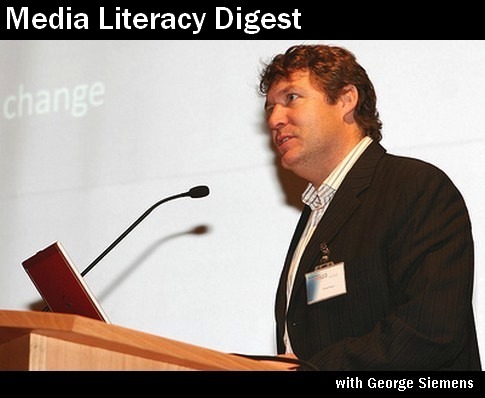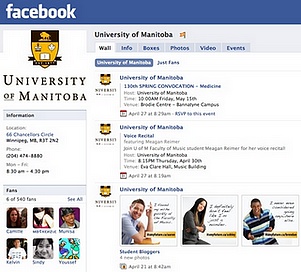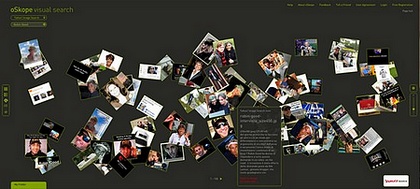 (Note: This article is the transcript of a talk given at Penn State)
(Note: This article is the transcript of a talk given at Penn State)
Good afternoon! My talk today is based on research that I have been doing for the last four years concerning youth and social media. This talk is an implications talk, not a research talk. So for the scholars in the room, I should warn you that I won't be diving into the research directly. (If you're interested in the research, check outhttp://www.danah.org/papers)
I have been asked to talk with you today about teens because they are tomorrow's college students. I am going to focus on American teen culture in order to narrow the scope, but we can get into international dynamics during the Q&A if you'd like.
Today's teens are growing up in a world where social media is everywhere. Regardless of whether or not they have access to these technologies or how they engage with them, there is little doubt that social media is playing a significant role in the changing landscape of American youth.
There are many ways to respond to this shift. The most popular response is panic. Every time a new genre of social media emerges and is adopted en masse by teens, many folks run around screaming that the sky is falling, the sky is falling! Of course, like clockwork, everything calms down once the old fogies begin adopting the technologies that they feared back when they were adopted just by the youngins.
Even those who aren't running around like chickens with their heads cut off are often convinced that EVERYTHING has changed because of social media. Even after adopting social media, many are absolutely convinced that the world of today's teens is completely and utterly different than it was "back in my day." And, of course, it always was better back then, right? ::wink::
Many of you have come to this symposium to hear about all of the amazing newfangled things that are happening because of technology. There are indeed some neat things going on. But, at the end of the day, the today's teens are not that much different than yesterday's teens as a result of technology.
Today's teens are still more interested in their friends than their lessons. They're still resistant to power and authority at variable levels. They still gossip, bully, flirt, joke around, and hang out. The underlying dynamics are fairly consistent. That said, technology is inflecting these practices in unique ways. And my goal here today is to talk about these inflection points.
I want to begin by talking about the everyday social. What are today's teens doing? I am going to then offer a structure for thinking about the shifts taking place before moving on to talk about the implications for learning and teaching.
Social Network Sites
I am going to focus on social network sites as a case study, because they are still the most massive and relevant case study we can work with. (This might be changing soon with mobile but we're not there yet.)
First, you'll notice that I'm saying "social network site" instead of "social networking site." This is intention. While you might be off using Facebook and MySpace to network with business colleagues, high school mates, and the hotty that you think you might want to date, most teens are not. They're focused on their friends. They use these sites to connect to people that they already know from school, church, activities, summer camp, etc.
One of the most problematic mistakes adults make when trying to make sense of social network sites is to presume that kids interact on these sites just like they do. This ain't true. Teens are using this space as a social hangout with their pre-existing network.
There are four features of social network sites that are relevant for us here today:
1. Profiles. Social network site profiles are where youth write themselves into being. Think of the profile as a digital body. Up until this point, you are an IP address and an IP address can't be dolled up for show and tell. With a profile, a teen can express who they are. Keep in mind the audience. This is about showing off to known individuals. Thus, when teens saying that they're 95 and from Christmas Island, they know they're not and their friends know they're not. They don't care about data accuracy for the system - they care that their friends get a sense of who they are. Profile decoration is akin to decorating one's bedroom wall or locker (back before that was a fire hazard). It's all about self-expression for friends.
2. Friends. Social network site Friends are not the same as your closest and dearest. There are all sorts of reasons to list others as Friends, not the least of which is because it's socially rude not to. Don't assume that when people indicate that they are connected on this system that they like each other. One way of thinking about Friends is as intended audience. This is who teens think that they are hanging out with. Of course, this is also Ground Zero for psychodrama - there's nothing fun about having to answer the question "Are you my Friend, Yes or No?" from someone you know but don't care for.
3. Comments. Most adults look at the comments on teens' profiles or Wall and get all uppity. Sure, the conversation typically boils down to "Yo, wazzup?" "Not much.. you?" "Nothing... I'm bored." "Me too." But be honest with yourself - those conversations that you just had in the hallway about the weather... were they so much more meaningful? I don't think so. All of this is a process of social grooming. It's a way of acknowledging one another and connecting while also letting everyone in the room know that you're not a pariah. I mean, imagine if we all went into the hallway and stood by ourselves and didn't make small chat. Wouldn't we all feel really awkward? Right. So think of these Comments in that regard. Teens know how to have deeper conversations - this just isn't where those necessarily happen.
4. New Feed. When Facebook launched the News Feed (and MySpace copied it), micro-blogging emerged on social network sites. These "status updates" provide a reverse chronological stream of the state of being of one's network. Many of these are mundane notes, details about food, comments on life, the universe and everything.
Most of you are familiar with this kind of structure through Twitter. Many of you have already send a bazillion Tweets today - we've all been watching them. But before you go thinking that you're down with the kids, let's get one thing straight: according to Pew, the median age of the Twitterverse is 31.
That's right: this ain't kids' world.
Take a moment. Do not assume that youth will adopt every new form of social media. In fact, they won't. There are very good reasons for why they don't use Twitter, not the least of which has to do with the fact that their parents think it's cool. Of course, Ashton Kutcher might change this. But for the most part, teens aren't here and aren't humored with being this public.
So why are they here? What are they doing here? The first thing to understand is that there's social pressure to be where your friends are. This ain't new. It's about the mall, about the school dance, etc. You don't exist if you're not where your friends are.
Skyler (18, Colorado): If you're not on MySpace, you don't exist.Tara (16, Michigan): Like everyone says get a Facebook. You need to get one.
Of course, just because teens want to gather with their friends doesn't mean that social network sites are the ideal place. Often, being offline together with friends is much more preferred.
danah: If you could choose between hanging out with friends or being online with them?
Tara (16, Michigan): Oh, hang out, for sure (laughs).
Lila (18, Michigan): But if you don't have the option, then you can just go online.
But they still have good reasons for getting together online with friends, not the least of which is because they aren't allowed out. Teens often turn to them because they don't have other spaces in which they can gather with peers.
Amy (16, Seattle): My mom doesn't let me out of the house very often, so that's pretty much all I do, is I sit on MySpace and talk to people and text and talk on the phone, cause my mom's always got some crazy reason to keep me in the house.
Of course, at the end of the day, social network sites are a great hang-out place, a great place to coordinate, and a great place to share. In fact, there's a lot about the way in which youth interact here that signals that it's just like any other public space. Now here's where we need to think about structure. How are these environments similar or different to other public spaces?
Properties and Dynamics of Networked Publics
There are five properties and four dynamics that you need to keep in the back of your head for thinking about these types of publics.
1. Persistence. What you say sticks around. This is great for asynchronicity, not so great when everything you've ever said has gone down on your permanent record. The bits-wise nature of social media means that a great deal of content produced through social media is persistent by default.
2. Replicability. You can copy and paste a conversation from one medium to another, adding to the persistent nature of it. This is great for being able to share information, but it is also at the crux of rumor-spreading. Worse: while you can replicate a conversation, it's much easier to alter what's been said than to confirm that it's an accurate portrayal of the original conversation. This is the cornerstone of bullying.
3. Searchability. My mother would've loved to scream search into the air and figure out where I'd run off with friends. She couldn't; I'm quite thankful. But with social media, it's quite easy to track someone down or to find someone as a result of searching for content. Search changes the landscape, making information available at our fingertips. This is great in some circumstances, but when trying to avoid those who hold power over you, it may be less than ideal.
4. Scalability. Social media scales things in new ways. Conversations that were intended for just a friend or two might spiral out of control and scale to the entire school or, if it is especially embarrassing, the whole world. Of course, just because something can scale doesn't mean that it will. Politicians and marketers have learned this one the hard way. And what does scale is often totally humiliating. This was learned by the kid with the light saber. Of course, for those who have been watching the Interwebz these days, you might have been pleased to watch the Susan Boyle meme take off. It's nice to have moments where the world seems kind and self-reflective, isn't it?
5. (de)locatability. With the mobile, you are dislocated from any particular point in space, but at the same time, location-based technologies make location much more relevant. This paradox means that we are simultaneously more and less connected to physical space.
Those five properties are intertwined, but their implications have to do with the ways in which they alter social dynamics. Let's look at three different dynamics that have been reconfigured as a result of social media.
1. Invisible Audiences. We are used to being able to assess the people around us when we're speaking. We adjust what we're saying to account for the audience. Social media introduces all sorts of invisible audiences. There are lurkers who are present at the moment but whom we cannot see, but there are also visitors who access our content at a later date or in a different environment than where we first produced them. As a result, we are having to present ourselves and communicate without fully understanding the potential or actual audience. The potential invisible audiences can be stifling. Of course, there's plenty of room to put your head in the sand and pretend like those people don't really exist.
2. Collapsed Contexts. Connected to this is the collapsing of contexts. In choosing what to say when, we account for both the audience and the context more generally. Some behaviors are appropriate in one context but not another, in front of one audience but not others. Social media brings all of these contexts crashing into one another and it's often difficult to figure out what's appropriate, let alone what can be understood.
3. Blurring of Public and Private. Finally, there's the blurring of public and private. These distinctions are normally structured around audience and context with certain places or conversations being "public" or "private." These distinctions are much harder to manage when you have to contend with the shifts in how the environment is organized.
I want to take a moment to drill down in on this last one because I think it's important and confusing. All too often, we hear statements about how privacy is dead. This is patently untrue. Consider this quote:
Bly Lauritano-Werner (17, Maine): My mom always uses the excuse about the internet being 'public' when she defends herself. It's not like I do anything to be ashamed of, but a girl needs her privacy. I do online journals so I can communicate with my friends. Not so my mother could catch up on the latest gossip of my life.
Bly is pointing out that the tensions between public and private are messy. More than anything, she's highlight how they're about control. That's key. Remember that youth see privacy in terms of control - control of space, control of information, control of trust.
MySpace Versus Facebook
Now, if you were paying attention, you'll notice that I put Facebook and MySpace on par. My guess is that most of you are on Facebook and eschew MySpace. Many of you might even believe that MySpace is dead. Let me tell you that this is NOT true. Quite the contrary, especially when we're talking about youth. Yet, there's something really disturbing going on here. These are two distinct public spaces that have attracted two different populations (with a decent amount of overlap). These distinctions have to do with history and adoption patterns, but they are also a reproduction of divisions within American society.
To get at this, I want to present two quotes from teens living in education-driven, upper-middle class environments:
Anastasia (17, New York): "My school is divided into the 'honors kids,' (I think that is self-explanatory), the 'good not-so-honors kids,' 'wangstas,' (they pretend to be tough and black but when you live in a suburb in Westchester you can't claim much hood), the 'latinos/hispanics,' (they tend to band together even though they could fit into any other groups) and the 'emo kids' (whose lives are allllllways filled with woe). We were all in MySpace with our own little social networks but when Facebook opened its doors to high schoolers, guess who moved and guess who stayed behind... The first two groups were the first to go and then the 'wangstas' split with half of them on Facebook and the rest on MySpace... I shifted with the rest of my school to Facebook and it became the place where the 'honors kids' got together and discussed how they were procrastinating over their next AP English essay."Craig (17, California): "The higher castes of high school moved to Facebook. It was more cultured, and less cheesy. The lower class usually were content to stick to MySpace. Any high school student who has a Facebook will tell you that MySpace users are more likely to be barely educated and obnoxious. Like Peet's is more cultured than Starbucks, and Jazz is more cultured than bubblegum pop, and like Macs are more cultured than PC's, Facebook is of a cooler caliber than MySpace."
There are all sorts of ways in which we can dissect the language that they are using, but what they are pointing to is a dynamic that exists that we're not so good at talking about: the reproduction of socio-economic status and class divisions in digital worlds. For those in the room who come from an education background, you may be familiar with Penny Eckert's work on "Jocks and Burnouts" - this is the same dynamic taken online. The majority of kids aren't cleanly jocks or burnouts but the tensions between these two extremes set the narrative through which most youth respond. The same is occurring with MySpace and Facebook.
You might be thinking: so what? Why does this matter? These are "natural" segregations anyhow, right?
Social network sites are not like email where it doesn't matter if you're on Hotmail or Yahoo. Teens who use MySpace can't communicate with those on Facebook and vice-versa. So if you don't participate, you're written out of the story. This means that divisions are re-inforced. Forget all of the rhetoric about how the Internet is the great equalizer - it's the great reproducer of inequality.
More importantly, I've listened as many of you have talked about doing things on Facebook because "everyone" is on Facebook. What about those who aren't? What happens to students who enter this university only ever having known MySpace? Are there differences in skills that need to be taken into account? What about familiarity and networks? What happens at school when everyone has been using Facebook for years except you?
More problematically, I've heard many of you talk about using Facebook directly in the classroom. And I've heard you talk about recruiting through Facebook. What kinds of assumptions are you making? Are you aware of these issues?
Understanding this issue is more complicated than I can express in a 45 minute talk but I encourage all of you to check out my writings on this topic because I think it's a pretty significant issue that many of you aren't accounting for. (See Chapter 5 of my dissertation athttp://www.danah.org/papers/TakenOutOfContext.pdf).
Learning
OK. Let's regroup and talk a little bit more explicitly about learning.
First, I want to make it VERY clear that sociality has learning implications. Youth engage with others to work out boundaries, to understand norms. This is how they learn power and authority, how they learn the networked architecture of everyday life. It's easy to eschew this, to argue that this is irrelevant, but most people spend a decent amount of their time working through social issues as a part of being an adult in this society. We talk about it as "politics" usually but it's about people. And teen years are where this is worked out.
It's also important to note the ways in which we need to learn to learn. Social media is connecting educators and learners in new ways and this too is extremely important. Consider, for example, this quote where a teacher helps a student in the off-hours on her MySpace:
A (16, CA): "Pleeeeeeeeeeease tell me why pre-calculus is important to me..."
Mr. C: "... You're not learning this stuff because you need it every day as an adult... The reason is that studying these things (precalculus, Shakespeare, ... whatever) helps you get good at learning how to learn. And that, you will definitely have to do for the rest of your life. That's practically all we do as adults..."
Of course, that doesn't address where and when technology is useful in the classroom. We all know that technology can be useful in education purposes. Many of you are deeply invested in bringing technology to the classroom. I'm speaking to the choir on this one.
But I want to make one thing clear... Just because youth are using social media doesn't mean that it can fit well into the classroom. It needs to be thought through pedagogically and y'all need to understand how it's being used in everyday life before bringing it into the classroom.
Since we're using social network sites as a case study, let me point out one of the places where they FAIL miserably. On social network sites, you have to publicly list your Friends and you have to have the functioning network to leverage it. What happens if you're an outcast at school? Does bringing it into the classroom make it worse? What happens if you're forced to Friend someone who torments you because you share a class? And then you have to face that person in your "private" space online as well? Bringing social network sites into the classroom can be very very tricky because you have to contend with social factors that you, as a teacher, may not be aware of.
While I'm hesitant to introduce many forms of social media into the classroom directly, I think that it is critical to see how they are reshaping information flow. This is actually where tremendous innovation opportunities emerge.
We all know that youth are searching for information in totally new ways so I'm going to skip over that. But they are also sharing differently. Sharing of information is very different in a world of bits where it's easy to make a duplicate and still retain what you originally had. Pointers have value and sharing information can create memes. Needless to say, youth are leveraging social media to share with their friends and peers. Now, most of what they share might be pure gossip, but teens also share links, references, ideas, and original content.
Of course, while adults are increasingly using sophisticated tools to aggregate and disseminate information, youth are predominantly not. Teens are not familiar with RSS feed readers or aggregators like Del.icio.us. Again, just because you use these forms of social media doesn't mean youth do. For the most part, teens are primarily sharing through IM and their SNS of choice. Or simply by word of mouth.
In the same vain, most teens live and breathe open systems like Wikipedia but have no idea how these systems work. They are typically told that Wikipedia is bad rather than being taught how to make sense of the information that is there.
Many of them are producing their own content without a critical understanding of remix or user-generated content. They're experiencing the blurring between consumption and production but they don't have a framework to make sense of this or to understand how to respond to attacks on their practices.
For all of the attention paid to "digital natives" it's important to realize that most teens are engaging with social media without any deep understanding of the underlying dynamics or structure. Just because they understand how to use the technology doesn't mean that they understand the information ecology that surrounds it. Most teens don't have the scaffolding for thinking about their information practices.
It's critical to realize that just because young folks pick up a technology before you do doesn't inherently mean that they understand it better than you do. Or that they have a way of putting it into context. What they're doing is not inherently more sophisticated – it's simply different. They're coming of age in a culture where these structures are just a given. They take them for granted. And they repurpose them to meet their needs. But they don't necessarily think about them.
Educators have a critical role when it comes to helping youth navigate social media. You can help them understand how to make sense of what they're seeing. We can call this "media literacy" or "digital literacy" or simply learning to live in a modern society. Youth need to know more than just how to use the tools - they need to understand the structures around them.
You need to understand what they're doing and why. Most importantly, you need to not reject what they're doing or fetishize it.
The modern world is certainly filled with neat new gadgets. Today's youth are certainly embracing many of them. Yet, at the end of the day, what they are doing is a lot like what previous generations were doing, inflected by the dynamics and features of the technology. So how do we face the next generation living and learning with social media?
We start by opening up a dialogue. We start talking to youth about what they are doing and why they are doing it. We ask them to teach us about the technology while we guide them with the knowledge that we have through experience. We start co-operating and engaging with the shifting nature of everyday life.
At the end of the day, the biggest disruption brought on by technology has nothing to do with the youth themselves, but with the way in which it forces us to reconsider our position of power as adults. We cannot simply tell it like it is; we need to re-learn how to learn and how to evolve with the changes all around us.
(Image source: www.parenttalktoday.com)


 (Note: This article is the transcript of a talk given at Penn State)
(Note: This article is the transcript of a talk given at Penn State)
































